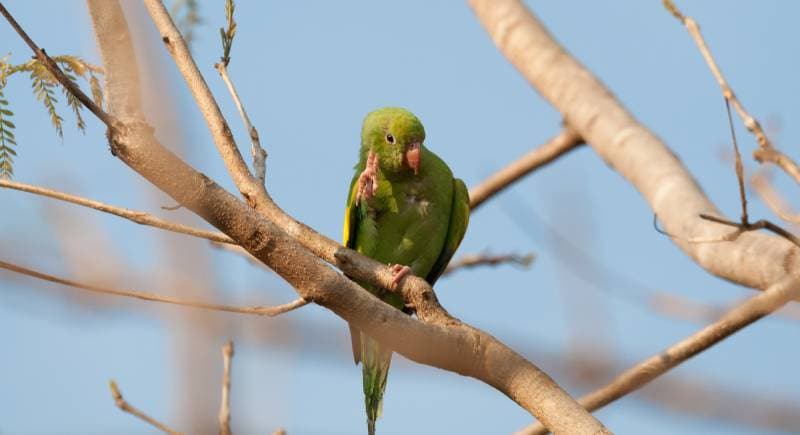
The information is current and up-to-date in accordance with the latest veterinarian research.
Learn more »
Pet birds, such as parakeets, can carry parasites like fleas. This isn’t as common as fleas on dogs or cats though, and other parasites are more prevalent.
Read on to learn more about fleas on parakeets, why they may be affected and the signs that an infestation can cause.
Do Parakeets Get Fleas? What About Other Birds?
External parasites, such as fleas, ticks, mites, and internal parasites, like tapeworms and roundworms, are small or microscopic organisms that live on or inside another organism. The relationship is one that benefits the parasite and harms the host—in this case, the flea gets what it needs from the bird, but the bird suffers.
Cat and dog fleas (Ctenocephalides canis and C. felis), although not species specific, rarely live on parakeets or other birds. However, one species of flea worth mentioning is the stickfast flea (Echidnophaga gallinacea). It is found in the tropics and subtropics, where it is a major poultry pest. Unlike other fleas, stickfast fleas attach themselves firmly to the skin of their host, often around the head. They can affect other pet birds including parakeets and severe infestation can cause anemia.
Image Credit: photowind, Shutterstock
How Are Flea Infestations Treated in Birds?
Flea infestation can be easy to diagnose since the fleas may be visible. Birds may also show signs like excessive preening, feather loss or mutilation, itching, and skin irritation. Diagnosis is based on a physical exam from a vet.
Depending on the infestation, the vet may recommend medication to treat the bird and their environment. External parasites like fleas are often treated with a topical or oral antiparasitic medication. The bird’s cage, perches, and toys must also be treated appropriately. If the fleas have infested your home or other pets, they must also be treated. Follow your vet’s directions carefully, many household sprays or treatments for other species are toxic to birds.
What Other Parasites Are Common in Parakeets?
There are other parasites more common than fleas, such as microscopic skin mites.
Infestation from the scaly face mite (Knemidokoptes pilae) may be confused with a flea infestation. When affected by these tiny skin-burrowing mites, parakeets will scratch and rub themselves and develop encrustation around the cere, beak, eye area, legs, or vent. Vets will usually scrape the skin and examine the sample under the microscope to confirm the diagnosis.
Related mites- scaly leg mites (Knemidokoptes mutans) burrows into the scales of the legs, causing flaking and swelling.
Depending on the mite, different treatment regimes will be required, so you should consult an experienced avian vet. Like fleas, mite infestations can quickly grow out of control.
Image Credit: New Africa, Shutterstock
Are Fleas and Other Parasites Harmful?
Pet birds, including parakeets, can get many different parasites, both internal and external. These parasites don’t usually cause serious illness or death when caught early, but they can, particularly in small, young, or compromised birds.
Like most illnesses, parasite infestations are much easier to prevent than treat. Keeping your parakeet well-fed, in good mental and physical health, and a clean environment are all crucial to preventing parasites. You should also take your bird to a qualified avian vet for twice-yearly exams to monitor their health and catch any problems early—parasites or otherwise.
Conclusion
Parakeets can have parasites, including fleas like a dog or cat. Fleas aren’t as common in birds as other pets, though they are prone to other types of parasite infestations. While flea infestations can be treated successfully, it’s important to take your bird to the vet regularly to prevent infestations and treat them quickly if they do occur.
Featured Image Credit: Vinicius Bacarin, Shutterstock






